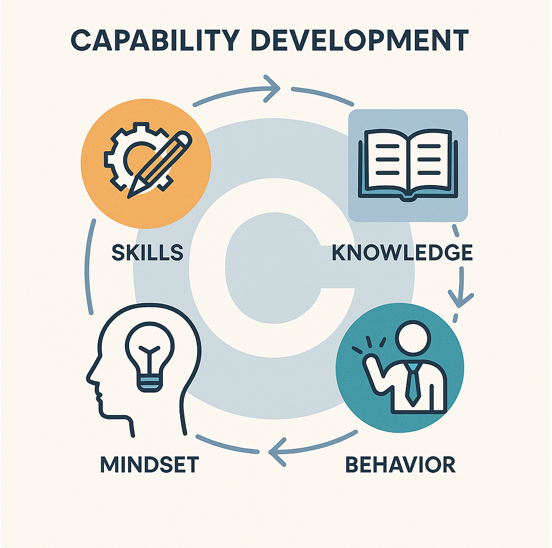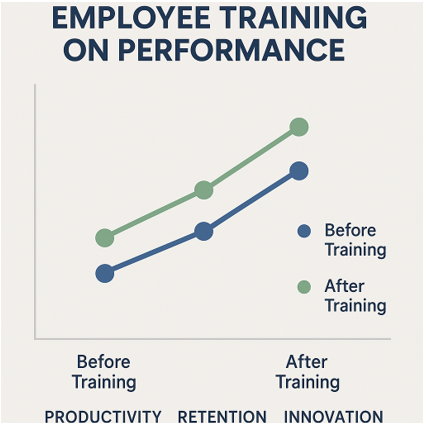|
Voiced by Amazon Polly |
In today’s dynamic business environment, organizations are increasingly recognizing the importance of employee training, capability development, and performance improvement. These elements are not just HR buzzwords—they are strategic tools that drive innovation, efficiency, and long-term success.
Customized Cloud Solutions to Drive your Business Success
- Cloud Migration
- Devops
- AIML & IoT
What Is Capability Development?
Capability development refers to the process of enhancing employees’ skills, knowledge, and competencies to meet current and future business needs. Unlike traditional training, which often focuses on specific tasks, capability development is holistic. It nurtures critical thinking, adaptability, and leadership—traits essential for navigating complex challenges.

Figure 1: A visual representation of capability development pillars—skills, knowledge, behavior, and mindset.
Why Employee Training Matters
Effective employee training programs are the foundation of capability development. They help bridge skill gaps, improve job performance, and foster a culture of continuous learning. Organizations that invest in training see measurable improvements in productivity, employee engagement, and retention.
Key Benefits of Training:
- Enhanced Performance: Employees perform tasks more efficiently and accurately.
- Increased Innovation: Training encourages creative problem-solving and experimentation.
- Better Retention: Employees feel valued and are more likely to stay with the company.
- Compliance and Safety: Training ensures adherence to industry standards and regulations.
Linking Capability Development to Performance
The impact of capability development on performance improvement is profound. When employees are equipped with the right capabilities, they contribute more effectively to organizational goals. This alignment leads to:
- Improved KPIs: Teams meet targets more consistently.
- Agile Workforce: Employees adapt quickly to change.
- Leadership Pipeline: Future leaders emerge from within the organization.

Figure 2: A graph showing performance metrics before and after training interventions.
Best Practices for Capability Development
To maximize the impact of training, organizations should:
- Conduct Skill Gap Analysis: Identify areas where training is needed.
- Personalize Learning Paths: Tailor programs to individual roles and career goals.
- Leverage Technology: Use LMS platforms, simulations, and microlearning.
- Measure Outcomes: Track performance metrics post-training.
CloudThat’s Role in Capability Development
At CloudThat, we specialize in delivering certification courses and custom training solutions that align with your business objectives. Whether you’re upskilling your IT team or preparing leaders for digital transformation, our offerings are designed to drive real-world impact.
CloudThat offers comprehensive Capability Development Training as part of its employee training solutions.
Conclusion
Investing in employee training and capability development is no longer optional—it’s a strategic imperative. By fostering a culture of learning and aligning development with performance goals, organizations can unlock their full potential and stay ahead in a competitive landscape.
Get your new hires billable within 1-60 days. Experience our Capability Development Framework today.
- Cloud Training
- Customized Training
- Experiential Learning
About CloudThat
CloudThat is an award-winning company and the first in India to offer cloud training and consulting services worldwide. As a Microsoft Solutions Partner, AWS Advanced Tier Training Partner, and Google Cloud Platform Partner, CloudThat has empowered over 850,000 professionals through 600+ cloud certifications winning global recognition for its training excellence including 20 MCT Trainers in Microsoft’s Global Top 100 and an impressive 12 awards in the last 8 years. CloudThat specializes in Cloud Migration, Data Platforms, DevOps, IoT, and cutting-edge technologies like Gen AI & AI/ML. It has delivered over 500 consulting projects for 250+ organizations in 30+ countries as it continues to empower professionals and enterprises to thrive in the digital-first world.
WRITTEN BY Reshu Goyal


 Login
Login


 August 18, 2025
August 18, 2025 PREV
PREV










Comments